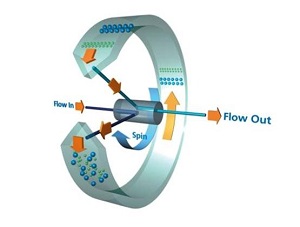Postnova Analytics kick off the New Year 2013 with a busy schedule of conference attendance, where they will share experiences and demonstrate their award-winning Field-Flow Fractionation (FFF) systems. Featured instrument, the CF2000, is the first commercial Centrifugal FFF system designed for routine use. This groundbreaking instrument was the recent winner of a major European industry award for innovation.
 The Postnova Centrifugal Field-Flow Fractionation separation principle
The Postnova Centrifugal Field-Flow Fractionation separation principle
The first chance to meet the team in 2013 will be at the 6th International Symposium on the Separation and Characterization of Natural and Synthetic Macromolecules (SCM-6) to be held in Dresden, Germany, from February 6 to 8, 2013. SCM-6 brings together scientists who share an interest in the separation and characterization of large molecules, and the conference creates a platform for delegates from diverging backgrounds with different perspectives to interact, discuss subjects of mutual interest, and discover new synergies.
Here, Postnova will present three posters – the first ‘Polymer Characterization using Thermal Field-Flow Fractionation’ illustrates the excellent potential of Thermal FFF (TF3) compared to common SEC analysis for different polymers, such as polystyrene, poly(methyl methacrylate), mixed polymer samples and blends thereof. The ability to separate by size and chemical composition within the one method, highlights the predominance of TF3 over standard SEC methodologies. The poster explains the principle of the Thermal FFF technique, with the separation taking place between a cold wall on the bottom of the channel and a hot wall on the top. The extraordinary capabilities of this FFF technique is the opportunity to not only separate by size but also by chemical composition due to thermal diffusion. The results comparing the analysis of a PS and PMMA Standards and its mixtures is undertaken with SEC and FFF, illustrating that only TF3 can achieve a separation. Also common drawbacks of packed columns like shear-degradation, are overcome with FFF technology.
The second of the posters is entitled ‘Characterization of Rubber Polymers by Flow FFF’ and explores the coupling of FFF technology of choice to suitable detector combinations (MALS, RI/UV). This enables the user to easily determine molecular weight and size distributions of macromolecules, which are important properties for polymers. Two synthetic rubber samples were analyzed and compared with a natural rubber sample.
The third poster focuses on ´Latex Nanoparticle Analysis by Flow FFF – DLS coupling´ and this explores the different separation forces applied, e.g. flow, thermal, centrifugal or gravitational. The techniques render variable results, enabling the end-user to choose the most appropriate technique of FFF-family separation to obtain the best performance for their particular application and nanoparticles. The poster shows that the FFF - DLS online coupling is a more precise tool for analysis of mixed latex nanoparticles, as opposed to traditional batch DLS measurements.
Also in February, Postnova will be in Kraków, Poland at the European Winter Conference on Plasma Spectrochemistry (EWCPS), being held from 10 to 15 February. The conference focuses on the major topics of analytical plasma spectrochemistry and Postnova Analytics will have on display the modular CF2000, which combines a powerful separation tool based on Field-Flow Fractionation principles, allowing the coupling to a range of different detectors like UV, DLS, MALS or even ICP-MS. The extended higher particle size separation range is between 7 nm to 50 µm, which provide a wide application range for characterization, such as proteins and polymers, from larger particles in one run with high resolution.
Rainer Jünger, Marketing Director of Postnova commented “FFF technology is providing huge benefits to scientists for the separation and characterization of macro species and particles, which are not able to be separated by other chromatography techniques. With the use of centrifugal field as the controlling force for the separation, particles in the laminar flow are separated by dynamic diffusion on the basis of size and density. This novel approach allows discrimination of materials that have the same particle size but different densities, which makes it ideal for nanoparticles but also is applicable in the microparticle size range. Jünger also added that another benefit is “there is no static phase in FFF separation so there is no interference, producing a very gentle separation. This is especially important for biological samples and cells, which might otherwise be damaged by being pressed through a column. Also it has a wide application range – for characterization of challenging biopharmaceutical, food, cosmetics, nanomaterial, but also environmental samples.”